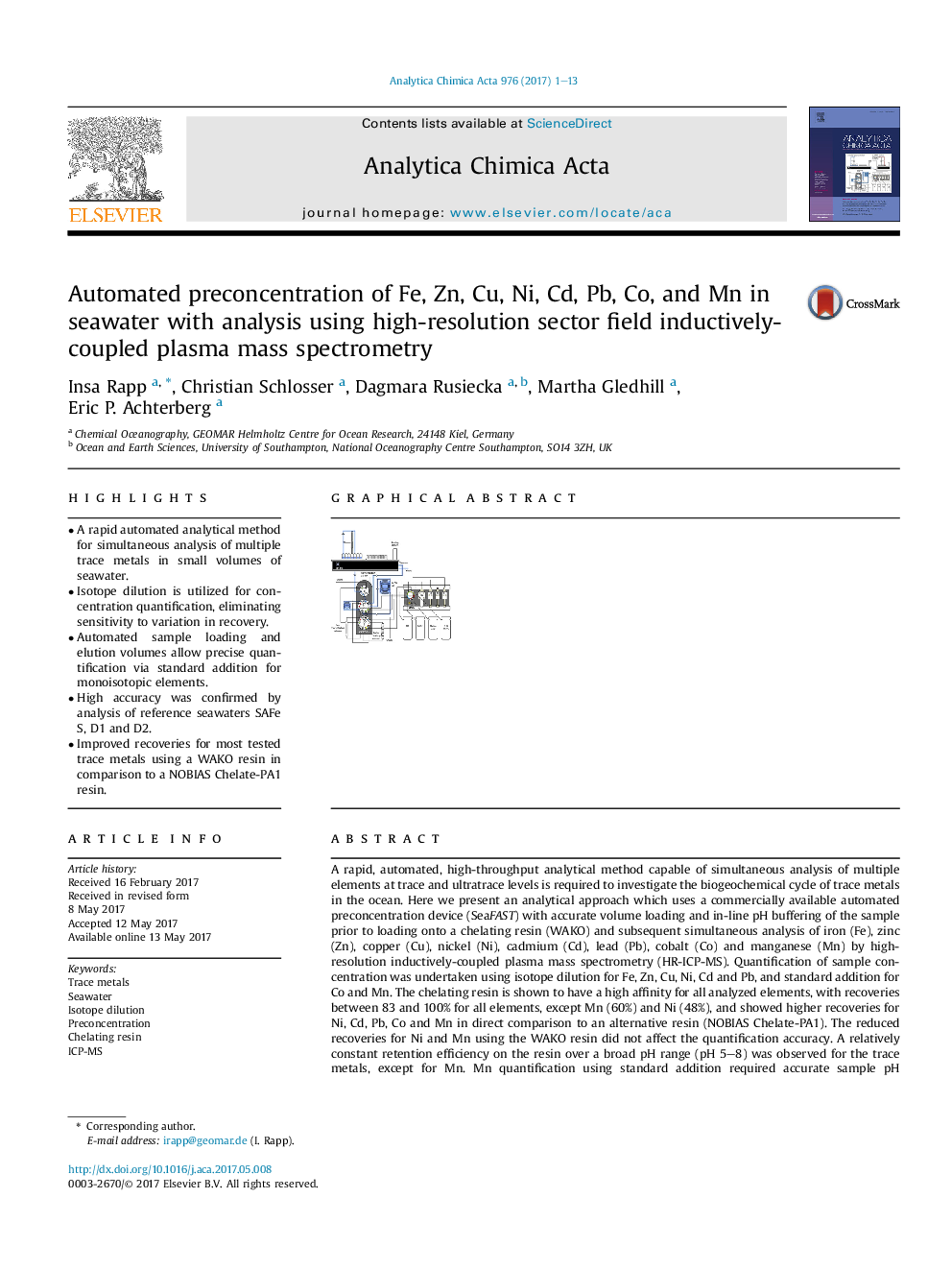| کد مقاله | کد نشریه | سال انتشار | مقاله انگلیسی | نسخه تمام متن |
|---|---|---|---|---|
| 5130779 | 1490856 | 2017 | 13 صفحه PDF | دانلود رایگان |

- A rapid automated analytical method for simultaneous analysis of multiple trace metals in small volumes of seawater.
- Isotope dilution is utilized for concentration quantification, eliminating sensitivity to variation in recovery.
- Automated sample loading and elution volumes allow precise quantification via standard addition for monoisotopic elements.
- High accuracy was confirmed by analysis of reference seawaters SAFe S, D1 and D2.
- Improved recoveries for most tested trace metals using a WAKO resin in comparison to a NOBIAS Chelate-PA1 resin.
A rapid, automated, high-throughput analytical method capable of simultaneous analysis of multiple elements at trace and ultratrace levels is required to investigate the biogeochemical cycle of trace metals in the ocean. Here we present an analytical approach which uses a commercially available automated preconcentration device (SeaFAST) with accurate volume loading and in-line pH buffering of the sample prior to loading onto a chelating resin (WAKO) and subsequent simultaneous analysis of iron (Fe), zinc (Zn), copper (Cu), nickel (Ni), cadmium (Cd), lead (Pb), cobalt (Co) and manganese (Mn) by high-resolution inductively-coupled plasma mass spectrometry (HR-ICP-MS). Quantification of sample concentration was undertaken using isotope dilution for Fe, Zn, Cu, Ni, Cd and Pb, and standard addition for Co and Mn. The chelating resin is shown to have a high affinity for all analyzed elements, with recoveries between 83 and 100% for all elements, except Mn (60%) and Ni (48%), and showed higher recoveries for Ni, Cd, Pb, Co and Mn in direct comparison to an alternative resin (NOBIAS Chelate-PA1). The reduced recoveries for Ni and Mn using the WAKO resin did not affect the quantification accuracy. A relatively constant retention efficiency on the resin over a broad pH range (pH 5-8) was observed for the trace metals, except for Mn. Mn quantification using standard addition required accurate sample pH adjustment with optimal recoveries at pH 7.5 ± 0.3. UV digestion was necessary to increase recovery of Co and Cu in seawater by 15.6% and 11.4%, respectively, and achieved full break-down of spiked Co-containing vitamin B12 complexes. Low blank levels and detection limits could be achieved (e.g., 0.029 nmol Lâ1 for Fe and 0.028 nmol Lâ1 for Zn) with the use of high purity reagents. Precision and accuracy were assessed using SAFe S, D1, and D2 reference seawaters, and results were in good agreement with available consensus values. The presented method is ideal for high throughput simultaneous analysis of trace elements in coastal and oceanic seawaters. We present a successful application of the analytical method to samples collected in June 2014 in the Northeast Atlantic Ocean.
189
Journal: Analytica Chimica Acta - Volume 976, 11 July 2017, Pages 1-13